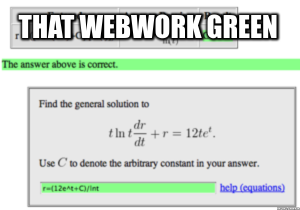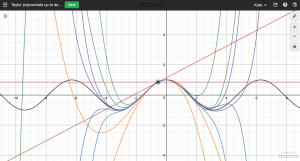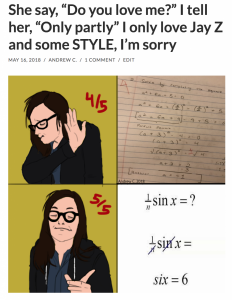The first day of class
One of the most important tasks of an instructor on the first day of class is to make the expectations of the course clear. On the first day of my class, I spend a long time introducing the course for my students. All course information is posted on the class OpenLab site, including the course description, the course outline, course policies, homework, exam dates, grading procedures, and important links. I take my students on a tour of the site and emphasize from day one that it is their site. Not only is all the information they need posted there for them to refer to throughout the semester, there is also the expectation that they will participate and collaborate. Students’ first assignment is to submit their own post to the OpenLab post introducing themselves to the class. This immediately creates a supportive and open environment for everyone and sets expectations for students to be responsible for their own contribution.
Introducing a new topic
One of my favorite obsessions is thinking about how best to introduce a new topic, especially one that students tend to find particularly tricky. I love experimenting with new approaches and remixing old ideas. One approach I like is to ask what seems like a basic question and then work with the class as a group—getting students’ ideas and input—to figure out what tools might need to be developed to approach it. The lesson I love the most begins like this:
Before attacking the problem, students submit their first wild guesses. Over the course of the lesson and, indeed, over the course of the whole unit on exponential and logarithmic functions, we return to this example, which keeps students interested, motivated, and engaged. Beginning a topic like this emphasizes that students already have the tools they need to attack unfamiliar problems, that chipping away takes time and involves some risk. We work together as a group and hold each other accountable for our contributions.
Collaboration
Many of my lectures are interactive, with the class and me working together as a whole to develop material and examples. For deep understanding, though, there is no substitute for students working, thinking and struggling on their own. Certainly, each student must spend time doing this alone, but they must also see the value in working together. During class is one of the only opportunities all students can be in the same place at the same time. Often, throughout the class, I arrange for them to work though examples in small groups and I circulate to address any issues that appear. Students’ contributions are recognized when they present their solutions on the board. This keeps students engaged and it strengthens their teamwork skills as well as their mathematical skills. While I have helped some of my students set up study groups outside of class, many study groups have sprung up on their own, both in person and over the OpenLab, which demonstrates that students are taking ownership of their own learning.
With the help of the OpenLab, I have developed a suite of assignments that I now use with every class before and after each term test. Providing students with review sheets before a test is very common. I no longer do this myself—I have students generate their own. Each student chooses one homework problem to solve and post on the OpenLab. As a class, they produce their own crowd-sourced review sheet. They are responsible for choosing appropriate questions, for a solution’s correctness and its style (see below). Further, they must think about what makes a good test question. Younger students in particular will choose questions that are too easy or too short to be appropriate for a test and this gives me an opportunity to see this thinking and redirect it. I also no longer make solution sheets for in-class tests myself—a similar assignment has students do it themselves and check each other’s work. By having the students do this heavy lifting, these assignments live at the intersection of my two priorities to make education accessible and foster independence.
Technology
In addition to the OpenLab, I use technology specific to math heavily in my classes and I expect my students to too. Most students today are at home on the internet and they embrace technology enthusiastically and seamlessley. I use technology to make myself more effective in making education accessible and in fostering independence. Two examples of technology I use continuously are WeBWorK and Desmos. Here are some details.
WeBWorK
WeBWorK is an free, open-source, online homework platform that many college and university math departments use. Individual students are assigned their own problems (based on a template) and WeBWorK tells them right away whether they have entered the correct answer. I have found my students engage with WeBWorK at a way higher level than they did with traditional textbook homework, which I now use as a complement to WeBWorK. They can work together without copying and they can instantly see their progress for themselves.
I can also supervise what each student is doing and I am in the habit of spying on their progress. Students are also more in contact with me than that were before I used WeBWorK as we can communicate about their specific problems directly through the site. Finally, there is a new and exciting WeBWorK-OpenLab integration, WeBWorK on the OpenLab, a completely open question-answer forum that is tied directly to students’ own WeBWorK problems. Where the use of a course OpenLab site is confined to students in a particular section, WeBWorK on the OpenLab is used by all students enrolled in a course. Private conversations I used to have with students over email (which were often similar enough that I copied and pasted my responses) now take place completely in the open. Especially since the feature is new, I love visiting to respond to students’ questions when I know that these responses might help other students, both in the present and in the future.
Desmos
Desmos is primarily an online graphing tool which is available to use in a web browser completely for free, even without an account. Desmos is much more user friendly than an old-fashioned graphing calculator, which now costs more than $100, and I use it partly to help students understand how what their own calculators can do. Mainly, I use Desmos in class to support visual learners as well as learners who struggle to visualize. I create interactive graphs that I save and share with my students so they can play around to see how different parameters change a picture.
I demonstrate to students how easy to pull up Desmos whenever it would be helpful to have a graph to refer to. Students quickly catch on that it is easy for them to do so too, when they are working independently.
Quizzes and exams: style matters
The only drawback of using WeBWorK for homework is that it emphasizes that the final answer is what is important. This is not the case at all: the logical progression and clear presentation of a student’s thinking is what matters. Even carefully scaffolded problems cannot offer the opportunity for a student to tell the complete story of the solution to a problem. To counteract this, I give weekly short quizzes in class as well as formal exams and I do something very unusual when I grade them. For each question I give, one point is for the answer’s “style.” Style goes beyond boilerplate instructions for students to “show their work.” To earn the style point, students must tell a clear and logical story, using correct terminology and mathematical symbols throughout. Writing like this can be a real challenge for students who have never learned how to use an equal sign correctly and never been told why it is important. Using correct style goes beyond communicating with another person; thinking about it carefully forces a student organize their thinking and question what they are doing at each step—it helps them understand the content better. Since this “style point” is so unfamiliar to students, I spend a lot of time, particularly early in the semester, explaining what it means and why it matters. I give examples of good and bad style of my own on the board, I constantly comment on style when I circulate when students are working in groups, and students help each other with style when presenting their own solutions at the board. Commenting on student work about why a style point was or was not awarded consumes a lot of time, but it is very rewarding when something clicks for a student and they understand or communicate something that they previously could not.
Style becomes such a presence in my class that it appeared in a math meme contest I held as an extra-credit assignment in one class. This was the incredible winning entry:
Projects
In most of my classes, homework, quizzes, and exams are supplemented with special projects. These take different forms, depending on the class, but I have found that a well-designed project can engage even students who have checked out. I try to base project prompts or themes around topics that students might encounter in their lives and I try to structure the tasks so that they require deep thinking yet each step is tractable. Typically, a project can be completed in or week or two, sometimes independently and sometimes with a partner.
One tool that I have found works very well for lower-level classes like MAT 1275 and 1375 is the Desmos Activity Builder. I have created modules as open educational resources that walk students step-by-step through the development of some new mathematical machinery. In one such project, they answer real-life questions about borrowing money to derive the formula for compound interest and the closed form for the sum of a finite geometric series.
By developing the theory behind these topics, students understand course content as well as one of the most important topics in their own financial lives at a deeper level, both of which help them become more independent.







